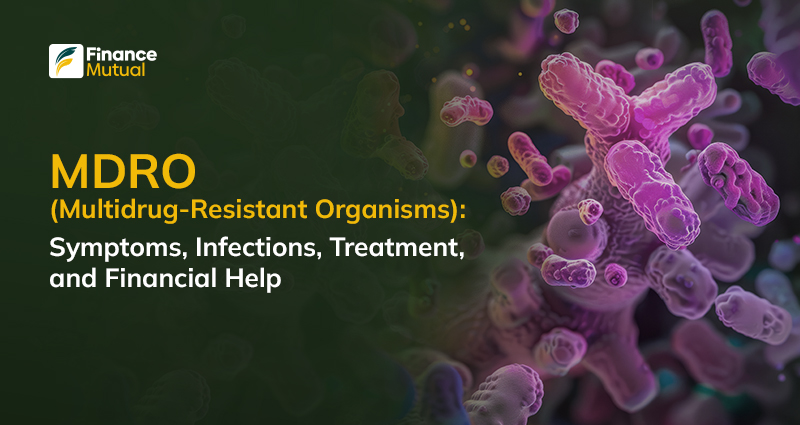
Quick Answer
MDRO Meaning
MDRO stands for multidrug-resistant organisms. MDROs are germs or bacteria that have developed resistance against three or more classes of antimicrobial drugs. The prevalence of MDRO infections has increased significantly in recent years and poses a threat to public health. These infections are especially concerning for people in hospitals, long-term care facilities, or those who have low immunity and existing chronic conditions.
Multidrug-resistant organisms (MDROs) are a growing public health concern worldwide. Patients and caregivers must understand everything about MDROs, from early recognition of symptoms to seeking proper care and navigating the overwhelming treatment costs.
This guide breaks down the meaning of MDROs, how they spread, symptoms to look out for, the types of infections they cause, and how you can cover the medical expenses related to these serious infections.
What is MDRO?
MDROs, or Multidrug-Resistant Organism microorganisms, are bacteria resistant to certain antibiotics typically used to treat infections. This resistance makes infections harder and more expensive to treat. Examples of MDRos include:
- Methicillin-resistant Staphylococcus aureus (MRSA)
- Vancomycin-resistant Enterococcus (VRE)
- Multidrug-resistant Streptococcus pneumoniae
- Multidrug resistant Mycobacterium tuberculosis
- Multidrug-resistant fungi such as Candida auris
As per the Centers for Disease Control and Prevention (CDC), more than 2.8 million multidrug-resistant infections occur every year in the U.S., resulting in 35,000 deaths.
What Is MDRO Infection and How Is It Diagnosed?
An MDRO infection occurs when invasive bacteria enter the body, usually after surgery, catheterization, or prolonged hospitalization. MDRO infections are not always apparent and may be mistaken for other common diseases.
An MDRO diagnosis typically involves laboratory testing of blood, urine, or wound cultures. A sample collected from the suspected area of infection is used to identify the bacteria and test them for antibiotic resistance.
MDRO Infection Symptoms You Should Watch For
The clinical symptoms associated with MDRO infections are similar to those of drug-sensitive organism infections. The most common MDRO infection symptoms include:
- Fever and chills
- Lethargy and fatigue
- Headache and body aches
- Persistent cough
- Prolonged feeling of discomfort
- Painful or uncomfortable urination
- Pus discharge from wounds
These symptoms can escalate rapidly and require prompt medical attention, particularly in vulnerable individuals like the elderly and those with a weak immune system.

Confused About Ultrasound Costs?
Learn what affects ultrasound prices — and how to find affordable payment options.
What Are the Causes and Risk Factors for MDRO Infections?
Some individuals are more susceptible to acquiring MDRO infections than others. Here are a few examples:
- Individuals with certain chronic medical conditions, such as chronic lung disease, end-stage liver disease, and renal failure
- People who have undergone organ transplants
- Those with medical devices installed in the body (eg, urinary catheters, dialysis catheters, endotracheal tubes, etc.)
- Patients admitted to the intensive care unit
- Patients with prolonged hospitalization
- Repeated visitors or attendees of healthcare facilities
MDRO vs MRSA: Are They the Same Thing?
While MDRO is a broad term that describes microorganisms resistant to antibiotic treatment, Methicillin-resistant Staphylococcus aureus (MRSA) is a subtype of MDRO.
Here are the key differences between MDRO and MRSA:
| Aspect | MDRO (Multidrug-Resistant Organism) | MRSA (Methicillin-Resistant Staphylococcus aureus) |
| Definition | A broad category of bacteria that resists treatment from multiple antibiotic classes | A specific type of bacteria (S. aureus) resistant to methicillin and similar drugs |
| Scope | Includes many bacterial types, such as VRE, CRE, and drug-resistant Gram-negatives | Only refers to methicillin-resistant strains of Staphylococcus aureus |
| Resistance Profile | Resistant to three or more antimicrobial classes | Resistant to beta-lactam antibiotics, including methicillin and penicillin |
| Common Settings | Frequently found in hospitals, long-term care facilities, and ICU wards | Common in both hospitals and community settings |
| Types of Infections | Can cause UTIs, pneumonia, bloodstream infections, surgical site infections | Often causes skin infections, abscesses, and occasionally serious infections like pneumonia or sepsis |
| Treatment Options | May require advanced or combination antibiotic therapies | Typically treated with vancomycin, linezolid, or other targeted antibiotics |
| Infection Control Measures | Strict isolation, PPE, contact precautions, and environmental disinfection | Similar precautions as MDROs, especially in healthcare settings |
List of MDRO Infections Commonly Treated in Hospitals
MDROs can cause many kinds of infections. Hospitals routinely encounter and manage cases of MDRO infections, particularly involving patients with weakened immune systems or those undergoing invasive procedures. Some common infections treated in clinical settings include:
- Urinary tract infections (UTIs)
- Bloodstream infections (bacteremia)
- Ventilator-associated pneumonia
- Surgical site infections
- Device-related infections (eg, catheters and ventilators)
Unlike other infections, these demand specialized care and a tailored antibiotic approach, as standardized treatments may not work against MDROs.
GNR Medical Abbreviation and Its Role in MDROs
GNR stands for Gram-Negative Rods. Multidrug-resistant gram-negative rods are bacteria generally found in human intestines. They are transferred via bowel movements and can spread if someone touches surfaces or equipment contaminated with infected stool. MDR-GNRs can also spread through healthcare workers in hospital settings.
Common Gram-Negative MDROs
Some commonly known gram-negative MDROs include:
- Escherichia coli (E. coli)
- Klebsiella pneumoniae
- Acinetobacter baumannii
GNRs play a major role in multidrug-resistant infections due to their natural and acquired resistance mechanisms. They have a strong outer membrane and additional resistance genes that enhance their ability to survive treatment. They are capable of causing serious illnesses, including bloodstream infections, pneumonia, urinary tract infections, etc.
This is why the treatment for GNRs is limited and costly, reinforcing the need for aggressive infection control measures and antimicrobial therapies.
Treatment Protocols for People With an Active Infection From a Multidrug-Resistant Organism
When diagnosed with an MDRO infection, seeking immediate and carefully planned treatment becomes crucial.
✦ Targeted Antibiotic Therapy
As these infections do not respond to standard antibiotics, healthcare professionals must conduct lab tests to identify if any specific antibiotics may still be effective. This process, known as antibiotic susceptibility testing, plays a crucial role in determining the most effective course of treatment.
✦ Intravenous (IV) Medication
MDROs are resistant to oral antibiotics. Treatment involves administering intravenous medication, ensuring quick delivery of high-strength medicines to the bloodstream. IV therapy may be given in a hospital or, rarely, at home through outpatient programs.
✦ Patient Isolation
Patients infected with multidrug-resistant organisms are placed in isolation rooms to prevent the bacteria from spreading to other vulnerable individuals. Healthcare professionals in hospitals use dedicated medical equipment to minimize direct contact and avoid cross-contamination.
✦ Strict Infection Control Measures
Hospitals follow strict MDRO infection precautions. Visiting family members are also encouraged to follow the same precautions to reduce the risk of spreading MDROs.
✦ Supportive Care
Together with antibiotics, patients usually need supportive care. This includes:
- Oxygen therapy for lung-related infections
- Fluids for hydration
- Pain management measures
- Wound care for the surgical site
- Nutritional support to nourish the immune system
✦ Adjusting And Monitoring Treatment
Healthcare professionals must closely monitor patients with MDROs to ensure that the infection is responding to treatment. The doctor may adjust the medication dosage or repeat the lab tests. This helps improve treatment outcomes, avoid complications, and hasten recovery.
MDRO Infection Precautions in Hospitals and Home Care
Multidrug-resistant organisms can easily spread from one person to another. There are even higher chances of contamination in home care and hospital settings, where many patients have low immunity. Therefore, hospital staff and caregivers must follow strict MDRO precautions for patient protection.
🏥 MDRO Precautions in Hospitals
In medical settings, MDRO precautions are a serious concern.
- Healthcare professionals must use personal protective equipment (PPE), including gloves, face masks, and gowns.
- Equipment used for the infected patient must not be shared with others.
- Hospital rooms must be disinfected properly and regularly.
- Staff must wash their hands thoroughly before and after patient interaction.
🏠 MDRO Precautions at Home
When a patient returns home, it is still important to follow hygiene protocols. Caregivers and family members should:
- Wash their hands frequently with soap and water.
- Use disposable gloves when handling bodily fluids or cleaning wounds.
- Wash clothes and linens in hot water.
- Disinfect frequently touched surfaces.
- Avoid sharing personal items such as razors or towels.
By continuing these MDRO precautions, families can keep other members safe and support a quick and smooth recovery.
What Individuals With an Active Infection From a Multidrug-Resistant Organism Would Typically Require
Individuals with an active MDRO infection typically require a higher level of medical attention and care compared to standard infections. Treatment for MDROs is more complex, longer, and often more expensive.
Beyond treatment, patients require extended hospital stays, frequent lab tests, and close monitoring. Even after discharge, they continue to need home care services, follow-up visits, physical therapy, and emotional support, especially after struggling with a serious infection.
For many families, the costs associated with long-term treatment can create added stress during an already hard time. In such situations, flexible payments—like the kind offered by FinanceMutual—can make MDRO treatment affordable and easily accessible.
Covering the Cost of MDRO Treatment: How FinanceMutual Can Help
Infections caused by drug-resistant bacteria lead to more deaths and health complications, longer hospital bills, and higher medical bills. As per research, treating these infections can cost $6,000 to $30,000 more per patient than treating infections sensitive to regular antibiotics.
FinanceMutual offers flexible financing solutions designed to fit your unique financial situation. FM uses AI-powered recommendations to create personalized payment plans without hard credit checks. You can begin your MDRO medical treatment without facing the large upfront costs and breaking them into affordable monthly payments.
Conclusion
MDRO infections are complex, potentially life-threatening, and financially overwhelming. They require prompt treatment and strict precautionary measures. But, navigating the costs of treatment should not be a hurdle. Whether it’s specialized antibiotics, home care support, or extended hospital stays, FinanceMutual’s flexible payment options make treatment accessible and affordable. Don’t let financial stress delay critical MDRO care and focus on your healing journey.

FAQs About Multidrug Resistant Organisms
1. What is MDRO Medical Abbreviation?
MDRO stands for “Multidrug-resistant organisms”.
2. What Are the Common MDRO Symptoms?
Common MDRO symptoms include fever, chills, painful urination, redness around wounds, persistent cough, etc.
3. Are MDR Bacteria the Same as “Superbugs”?
Yes, MDR bacteria are often called “superbugs” because they resist multiple antibiotics. Not all superbugs are the same—some may resist a few antibiotics, while others can shield themselves against nearly all available treatments.
4. What Does Colonization With MDR Bacteria Mean, and Should I Be Worried?
Being colonized by MDR bacteria means the bacteria are present in your body, probably on your skin, nose, or gut, but aren’t causing an active infection. You won’t have symptoms or feel sick, but you still pass on the bacteria to others.
5. Which Multidrug Resistant Organisms (MDROs) Cause High Death Rates?
Some MDROs are linked with high mortality and morbidity rates, especially in vulnerable populations. Here’s what research has found:
- Carbapenem-Resistant Acinetobacter baumannii (CRAB) has a mortality rate of approximately 54.2% within 28-30 days.
- The mortality rate for Carbapenem-Resistant Escherichia coli (CREC) exceeds 50% within 28-30 days.
- Carbapenem-Resistant Klebsiella pneumoniae (CRKP) has high mortality rates of at least 40% within 28-30 days.
6. Can I Catch an MDRO Infection From Touching Things in Public Places?
MDROs usually spread in hospitals or long-term healthcare facilities, not in everyday public places. However, you should maintain good hygiene, especially by washing your hands after touching shared surfaces.




